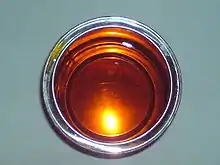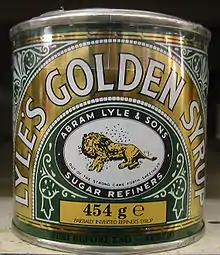Golden syrup
Golden syrup or light treacle is a thick amber-coloured form of inverted sugar syrup made by the process of refining sugar cane or sugar beet juice into sugar, or by treatment of a sugar solution with acid. It is used in a variety of baking recipes and desserts. It has an appearance similar to honey and is often used as a substitute where honey is unavailable or prohibitively expensive.
 Golden syrup's characteristic amber colour | |
| Alternative names | Light treacle |
|---|---|
| Place of origin | England |
| Main ingredients | Refined sugar cane or sugar beet juice |
It is not to be confused with amber corn syrup or amber refined sugar. Regular molasses, or dark treacle, has both a richer colour and a strong, distinctive flavour.
Formulated by the chemists Charles Eastick and his brother John Joseph Eastick at the Abram Lyle & Sons (now part of Tate & Lyle) refinery in Plaistow, London, Lyle's Golden Syrup was first canned and sold in 1885.[1] In 2006 it was recognised by Guinness World Records as having the world's oldest branding and packaging.[1]
History

In 1863, Abram Lyle, owner of a cooperage, became owner of the Glebe Sugar Refinery in Greenock, in lieu of a debt. He became aware of the fact that a by-product of the sugar refining was a syrup which was usually sold off cheaply as pig-food. He thought that, given some adjustment, this syrup could be adapted for human consumption. His company did well and expanded to London.[2]
In 1883, Charles Eastick, an English chemist at the Abram Lyle & Sons (now part of Tate & Lyle) refinery in Plaistow, east London, further formulated how sugar could be refined to make a preserve and sweetener for cooking, bringing it to its current recipe. Charles and his brother John Joseph Eastick experimented with the refining process, of the bitter molasses-brown treacle—hitherto a waste by-product of sugar refining—into an eminently palatable syrup with the viscosity, hue, and sweetness of honey.[3] The resulting product was marketed commercially in 1885 as "golden syrup".[4] The name "golden syrup" in connection with molasses had occurred, however, as early as 1840 in an Adelaide newspaper, the South Australian.[5]

The tin bears a picture of the rotting carcass of a lion with a swarm of bees and the slogan "Out of the strong came forth sweetness". This is a reference to the Biblical story in chapter 14 of the Book of Judges in which Samson was traveling to the land of the Philistines in search of a wife. During the journey he killed a lion, and when he passed the same spot on his return he noticed that a swarm of bees had formed a comb of honey in the carcass. Samson later turned this into a riddle at a wedding: "Out of the eater came forth meat and out of the strong came forth sweetness".[7] While it is not known exactly why this image and slogan were chosen, Abram Lyle was a deeply religious man, and it has been suggested that they refer either to the strength of the Lyle company or the tins in which golden syrup is sold.[4] In 1904, they were registered together as a trademark,[4] and in 2006 Guinness World Records declared the mark to be the world's oldest branding and packaging.[8] Lyle's golden syrup was awarded a Royal Warrant in 1911.[4]
In 1921, Lyle's business merged with Tate, a sugar-refining firm founded by Sir Henry Tate in 1859, to become Tate & Lyle. In 2010, Tate & Lyle sold its sugar refining and golden syrup business to American Sugar Refining.
Originally, golden syrup was a product made at the white sugar refinery from the recovered mother liquor (recovered molasses) "washed" off the raw sugar crystals in the process of creating white sugar. This liquor is generally known as refiners return syrup. Today most golden syrups are produced by a specialist manufacturer by inverting half the refiners return syrup to fructose and glucose and blending it back again; this ensures the product remains liquid and will never re-crystallize.
Production
Refiners syrup begins as a high-Brix, pale sucrose syrup made from white sugar and water designed to loosen the dried molasses found on raw sugar crystals. The sucrose saturated content of the initial "green" syrup impedes sugar crystals from dissolving during the process of washing. The purpose is to mix the green syrup with raw sugar crystals to form a "magma" of 8–10% moisture content at around 60–65 °C that is then washed with water in a centrifuge. After the first washing (often termed affination) the "washed off" molasses combines with the sucrose syrup to generate refiners return syrup, which is generally re-used several times until deemed spent.[9][10] The spent refiners return syrup is sold off to manufacturers for golden syrup production or is sent to a recovery section of the refinery often called the remelt house or boil-out section. Here it is reheated to crystallize and recover the sucrose it contains and that is returned to the affination stage. The final spent syrup left after the recovery process is sold as treacle (often called refiners molasses in older texts).[11][12]
An equivalent golden syrup product may be made from beet sugar by processing the clarified, partially evaporated beet juice to break down (invert) most of the disaccharide sucrose into its constituents monosaccharides glucose and fructose. In this process none of the sucrose is ever crystallized from the beet juice. Inversion may be done by acid hydrolysis or by adding an enzyme, invertase. This produces a free flowing (invert) syrup that will not crystallize. Typically in acid hydrolysis, the disaccharides are split by hydrochloric acid, resulting in a solution which is acidic; neutrality is restored by the addition of lye, which is sodium hydroxide. As a result, syrup made by this method contains some common salt, sodium chloride.
The free glucose and fructose present in golden syrups are more water-soluble than the original sucrose. As a result, golden syrups are less likely to crystallize than a pure sucrose syrup. The free fructose content gives the syrup a taste sweeter than that of an equivalent solution of white sugar; when substituting golden syrup for white sugar, about 25% less golden syrup is needed for the same level of sweetness.
The term invert comes from the method used for assessing sugar syrups. The plane of linear polarised light passed through a sample of pure sucrose solution is rotated to the right. As the solution is converted to a mixture of sucrose, fructose and glucose, the angle of rotation reduces, through zero and then increases in the opposite direction, thus the direction appears to have been inverted compared to light passed through the sucrose solution.
Availability
Golden syrup is widely available across the world, made either from sugar cane or sugar beet.
Lyle's Golden Syrup, made by Tate & Lyle, remains one of the best known UK brands. There are two other UK sugar refiners, British Sugar who make an equivalent product under its Silver Spoon brand, and Ragus Sugars, who make the Eastick's & Ragus Golden Syrup brand.[13]
In South Africa, the most popular brands are the locally produced Illovo golden syrup and the imported Lyle's Golden Syrup. In addition to the classic golden syrup, several flavoured versions are also marketed, notably maple flavour.
In Australia, CSR Limited is the major producer, but it is also produced by Bundaberg Sugar and Smith's.
In New Zealand, Chelsea golden syrup has been a household name since the late 19th century.
Rogers Golden Syrup and Lyle's golden syrup are available in Canada. In Canada, Lyle's Golden Syrup is available in either a glass jar or the traditional tin.
King brand syrup, a mixture of corn and invert syrup, is sold in many areas of the US, often grouped with table syrups like maple syrup. Speciality stores or those with international sections, such as Whole Foods Market and Cost Plus World Market, often stock Lyle's golden syrup from the UK in several different packs.
In Germany, a similar product called Zuckerrübensirup (literally "sugar-beet syrup") is a popular spread, especially in the western part of the country around Cologne. The best known producer is the Grafschafter Krautfabrik which has produced Zuckerrübensirup for more than a hundred years. This syrup is almost always made from sugar-beet; golden syrup from sugar cane is extremely rare on the German market. There are two types of Zuckerrübensirup in Germany, a golden one, similar to golden syrup from sugar cane, and a brown syrup which is similar to dark treacle. The German company Schneekoppe makes a product called Frühstücks-Sirup (breakfast syrup), which is a golden syrup with some added natural flavor to imitate the taste of honey.
In Sweden there is a light and a dark golden syrup, beet based.[14]
Properties
Golden syrup is a Newtonian fluid. Its density is approximately 1430 kg·m−3 at room temperature,[15] and its viscosity is 210 Pa·s at 12 °C.[15]
See also
Syrups
Other
Notes
- "Golden celebration for 'oldest brand'". BBC. 24 February 2018.
- Made in Scotland: Lyle's Golden Syrup
- Mallett, Delwyn (May 2016). "Lyle's Golden Syrup". OCTANE.
- "Lyle's – past and present". Tate & Lyle. 2008. Archived from the original on 20 February 2008. Retrieved 9 April 2008.
- Birch, Adrian (29 August 1840). "Reference to golden syrup". The South Australian. Retrieved 25 April 2014.
- "Oldest branding (packaging)". Guinness World Records.
- Judges 14:14
- "Sweet success for 'oldest brand'". BBC News. 28 September 2006.
- Chen, J; Chou, C.C. (1993). Cane Sugar Handbook: A Manual for Cane Sugar Manufacturers and Their Chemists. pp. 486–487.
- http://nzic.org.nz/ChemProcesses/food/6E.pdf
- Varzakas, Theodoros; Labropoulos, Athanasios; Anestis, Stylianos (2012). Sweeteners: Nutritional Aspects, Applications, and Production Technology. CRC Press. p. 168. ISBN 978-1-4398-7672-5.
- Kent, James A. (2013). Handbook of Industrial Chemistry and Biotechnology: Volume 1 and 2. Vol 1. Springer. pp. 1675–. ISBN 978-1-4614-4259-2.
- "Ragus Heritage". YouTube.
- "Syrups in Sweden". Swedishfood.com. Retrieved 12 March 2018.
- "Syrup – Volcanology analogues".
References
- "Lyle's – past and present". Tate & Lyle. 2008. Archived from the original on 20 February 2008. Retrieved 9 April 2008.
External links
 Media related to Golden syrup at Wikimedia Commons
Media related to Golden syrup at Wikimedia Commons
